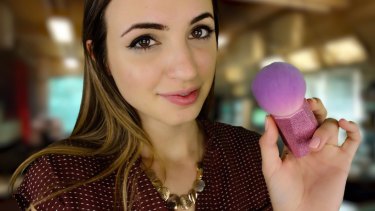When Jennifer Allen watched videos of space, she sometimes felt this peculiar sensation: a tingling that spread through her scalp as the camera pulled back to show the marble of Earth. It came in a wave, like a warm effervescence, making its way down the length of her spine and leaving behind a sense of gratitude and wholeness. Allen loved this feeling, but she didn't know what caused it. It was totally distinct from anything she'd experienced before. Every two years or so, she'd take to Google. She tried searching things like "tingling head and spine" or "brain orgasm". For nine years, the search didn't turn up anything.
Then, around 2009, it did. As always, Allen typed her phrases into Google, but this time she got a result on a message board called SteadyHealth. The post was titled "WEIRD SENSATION FEELS GOOD": "i get this sensation sometimes. theres no real trigger for it. it just happens randomly. its been happening since i was a kid and i'm 21 now. some examples of what it seems has caused it to happen before are as a child while watching a puppet show and when i was being read a story to. as a teenager when a classmate did me a favour and when a friend drew on the palm of my hand with markers. sometimes it happens for no reason at all."
Today legions of (mostly female) creators release hundreds of new videos on YouTube each day. Credit: Hannah Whitaker
In the discussion, many described a similar feeling – a "silvery sparkle" inside the head, a euphoric "brain-gasm" or a feeling like goosebumps in the scalp that faded "in and out in waves of heightened intensity". Many people agreed that the sensation was euphoric. ("Aside from an actual orgasm, it's probably the most enjoyable sensation possible," one user wrote.) Its triggers were as varied as watching someone fill out a form, listening to whispering sounds or seeing an artist paint landscapes on TV.
Allen scrolled through pages and pages of discussion. Oh my gosh, she remembers thinking. These people are talking about exactly what I experience.
In time, that post begot a second post: "WEIRD SENSATION FEELS GOOD – PART 2". As discourse on the unnamed feeling evolved, users shared accidental triggers found online – a man unlocking a damaged padlock, someone brushing her hair. These videos had a gentleness in common that many of the users found hard to describe. Some spoke of the need for a research group to better understand the sensation. Still others expressed fear over social repercussions: Were they perverts? Were they sick?
"People had been told they were on drugs or that they had lice – things like that," Allen says. "And then there was the factor of people calling it a 'brain orgasm' and it sounding like some sort of erotic fetish kind of thing."
Allen had invested a lot in the discussion, even expressing interest in the fledgling research effort. She saw how the feeling had improved her sense of calm, but she worried that the subtext of a "tingling sensation" would hold the group back from legitimacy. If they wanted to generate scientific interest, they needed a more scientific-sounding name.
And so in 2010, she made one up: Autonomous Sensory Meridian Response, or ASMR. She started with "autonomous" because it was a feeling from within; "sensory" was self-explanatory. "Meridian" worked triple duty, suggesting peak but also orgasm and the energy pathways of traditional Chinese medicine. "Response" was just to say that it was not a constant state; it happened in reaction to a set of stimuli, like gum chewing and tapping. "I wish I'd made it a little shorter," Allen says. But at least it sounded better than "brain-gasm".
She debuted the new name on the SteadyHealth board by announcing the "ASMR Group" she had registered on Facebook. Discussion-board users migrated en masse, and soon membership spanned six continents: a blogger in South Africa, an artist in Detroit, an ethnobotany researcher working in northern NSW. They started sharing links to videos again – not the accidental triggers of before but a new genre created for the express purpose of inducing ASMR. These videos often featured anonymous women delivering soft-spoken voice-over narration. According to message-board lore, the first video of this type was one titled Whisper 1 – hello! that was posted in 2009. Under the search engine-friendly banner of ASMR, a new crop of YouTube creators emerged to serve up the feeling to those who knew they felt it – at that point, a small but growing subset of the public.
Today legions of (mostly female) creators release, by my count, about 500 new videos on YouTube each day. Over the course of reporting this article, I spent at least 200 hours on the site, watching women chew gum, swallow octopus sashimi, simulate eye exams, turn pages of books and peel dried glue off artificial ears. I watched a teenage girl role-play as a 14th-century nun, treating me for the bubonic plague. I watched a two-hour recording of hairdryer sounds.
Any trigger that starts to find fans is endlessly taken up and re-performed – ripped off by different channels for ad dollars – at least until the next trigger takes its spot. One month, cranial nerve exams are in. The next month, creators are all shaving bars of soap, chewing bricks of raw honeycomb or eating buckets of KFC. This subculture is bonded not by belief but rather by an ineffable sensation – perhaps the first time the internet has revealed the existence of a new feeling.
Craig Richard, a professor of physiology at Shenandoah University in Virginia, USA, first heard the term "ASMR" in 2013, on a podcast. "I'm listening to the beginning of this episode thinking, 'This is a bunch of woo-woo bunk!'" he tells me. Just as he went to turn the podcast off, the subject changed to the late American painter Bob Ross, who hosted an instructional television TV show in the US in the 1980s and early '90s – and who was also a well-known ASMR trigger. Richard's eyes lit up. In childhood, he spent afternoons watching Ross paint landscapes on TV. He remembered caring more about the painter than the painting. "It was his demeanour. It was the sounds he made and the way he talked – the way he looked in the camera."
When the episode was over, Richard went to his computer to look up the research on ASMR. At that point, he found nothing academic – only websites and forums that led him to the Facebook group. He reached out to Allen, and in collaboration with a graduate student and member of the community named Karissa Burnett, they conducted an informal online survey that, over time, has received more than 25,000 voluntary responses. Richard also started ASMR University, an online archive that today remains a useful clearinghouse of research on the topic.
Still, scientific understanding has moved slowly. Funding for ASMR research is hard to justify, and the diverse nature of ASMR triggers can lead to "noisy" data. To date, ASMR University lists just 10 peer-reviewed papers. More than half of these were published in author-pay journals. The most rigorous studies use functional magnetic resonance imaging to map the activity of blood flow in the brain as participants report feeling the tingles. Outcomes have suggested, in very small samples, that ASMR might have something to do with socially bonding "affiliative behaviours", known to release feel-good hormones like oxytocin.
Richard, for his part, considers these outcomes from an evolutionary-biology perspective. He believes that the tingles of ASMR are meant to assist in reproduction and survival, and points out that triggers like grooming, whispering and eye-gazing all bear strong resemblance to the ways that humans soothe infants. In adulthood, a range of similar behaviours contribute to intimacy between mates. But if ASMR plays (or played) a key survival role, why does it seem that only some people can feel it? Why should it come to our attention only now?
Gibi’s ASMR YouTube channel pays enough for her to treat making content as a full-time job.Credit:YouTube
Around the time that Whisper 1 – hello! was picking up speed in Allen's Facebook group, Gibi – today one of YouTube's top "ASMRtists" – was a sophomore in high school. (I've withheld her last name here for below-explained reasons.) Like many teenagers these days, she often had trouble falling asleep. Sometimes she would sneak her phone into her room and watch YouTube videos to relax her mind. Make-up tutorials segued to massage, which soon gave way to ASMR.
Since then, Gibi has watched ASMR videos every night. The ritual followed her off to college, where the videos became a kind of white noise while she studied. ASMR was, by that point, not just for those who experienced the tingles. The genre had begun to find broader appeal as a sleep aid, an alternative to guided meditation and a drug-free, online version of Xanax. It had developed its own microstars – women with handles like Gentle Whispering ASMR and ASMRrequests, who filmed themselves crinkling paper, tapping their nails on large wooden bowls, dealing cards, brushing hair and pouring cold milk into bowls of Cocoa Krispies.
One of Gibi's favourites, Heather Feather ASMR, went beyond mere sound effects, performing full-scale role-play scenes infused with attentive, deliberate sound. In one, Heather administered a colour-blindness test, tapping her wand on a laminated chart. Watching Heather's videos made Gibi feel as if her "brain was swimming, in a good way". She played the same scenes over on repeat, returning to parts that gave her the tingles.
At that point, in 2016, Gibi thought that maybe, with regular effort, she could produce a quality channel with a regular schedule that tested out new, creative triggers on a regular basis. And so, in the summer before her senior year, she started her own channel, Gibi ASMR. Six months after graduation, she was earning enough in ad revenue to treat it as her full-time job. Today, she has about 1.8 million subscribers on YouTube.
I first meet Gibi in Los Angeles at Daiso, a Japanese discount store. Our plan is to shop for some tingly props – any little odd or end that might yield good, recordable sound. Gibi is in town for a public appearance. Today, a video from her account is trending globally on YouTube, a role-play called The ASMR Sleep Clinic, Tingle Experiment. Gibi's main goal is to relax her fans.
"If you fall asleep during my video, that's a compliment," she says. Some of the most-requested content is the sound of fingers tapping on a bread-shaped piece of cork. Fans request the "toaster coaster" by name – the closest thing ASMR has to Lynyrd Skynyrd's Free Bird. Today, Gibi is searching for similar objects, made of soft, dull wood or thick glass. In the store, she makes a beeline towards a rack of piggy banks.
"Whenever I pick something up, I'm always listening to it," she says, tapping her nails on a piggy bank's candy-coated glaze. The lacquer makes a dainty, plinking sound, like the loose filament of a shaken, burnt-out light bulb. She moves on to rustle a strand of orange tinsel, then brushes her hand against the grain of a vellum birthday card.
Gibi is the LeBron James of touching stuff. As she pauses to fondle a make-up brush, I hear the grip of her finger pads reluctant to give up the cellophane wrapper. When she smoothes the fleece of a microfibre towel, I cringe at the drag of rough callous against terry cloth. Gibi moves with the demonstrative intent of a former high school theatre kid. (She is one.) She is attractive in the way of a friend's older sister, projecting an air of humble self-assuredness.
"I think a lot of what has to do with why my channel has become popular is because I do put a lot of my personality – oh, my god!" She stops to interrupt herself and crinkles a plastic package of pens. "I put a lot of my personality into my videos," she says.
A lot of the visuals you might see" in ASMR videos "relate to how you might visualise what happens during healthy foreplay.
For those who watch her at home, this apparent emotional availability can foster a range of attachments. Gibi says that most of her viewers are kind and effusive. Under her videos, they leave thousands of comments, appreciating the sound of her voice and its power to alleviate their insomnia, anxiety and post-traumatic stress disorder. For others, the tender tone can be misleading.
Unloading her shopping basket at the till, she tells me the story of one obsessive fan who believed she was talking directly to him. He sent her tens of thousands of messages, she says, and she filed a police report. Other fans have pried into her past, digging up old records from high school.
The gender imbalance of performers seems suspect. ASMR combines the one-way sociality of podcasts with the outcome-driven imperative of porn.Credit:Hannah Whitaker
Creepiness and harassment are widespread problems for the young female creators of the ASMR world. Gibi takes extreme precautions to protect her own privacy. She doesn't share her last name, or her relationship status, or even what city she lives in. If she happens to meet a fan on the street near her house, she pretends that she's there on holiday.
As a genre, ASMR seems doomed to appear sexual – a suspect jumble of tingles and pleasure and subservient women you watch alone at your computer. Are those who feel the tingles just a bunch of repressed weirdos? Questions like this have plagued ASMR ever since Jennifer Allen first cringed at the word "brain-gasm".
"A lot of the visuals you might see" in ASMR videos "relate to how you might visualise what happens during healthy foreplay", Craig Richard says. "People talking gently to each other, people touching each other lightly, gazing into each other's eyes, expressing physical or vocal care for each other – making the other person feel safe." If ASMR is not sexual itself, then Richard believes it might still belong to a general complex of safety, caring, connectedness and trust.
Nevertheless, the gender imbalance of performers seems suspect. ASMR combines the one-way sociality of podcasts with the outcome-driven imperative of porn. The viewing pattern even looks similar to porn, but this perhaps goes beyond mere horniness. For much of human history, women have been cast into care-taking roles. With centuries of imbalance, it makes plenty of sense that our brains would find peace in these strange and gendered invocations of comfort. Is that healthy? Is that normal? Really, who can say? Sitting alone in front of a screen, nothing seems that weird anymore.
To read more from Good Weekend magazine, visit our page at The Sydney Morning Herald, The Age and Brisbane Times
Edited version of a story first published in the New York Times. © 2019 The New York Times
Source: Read Full Article


